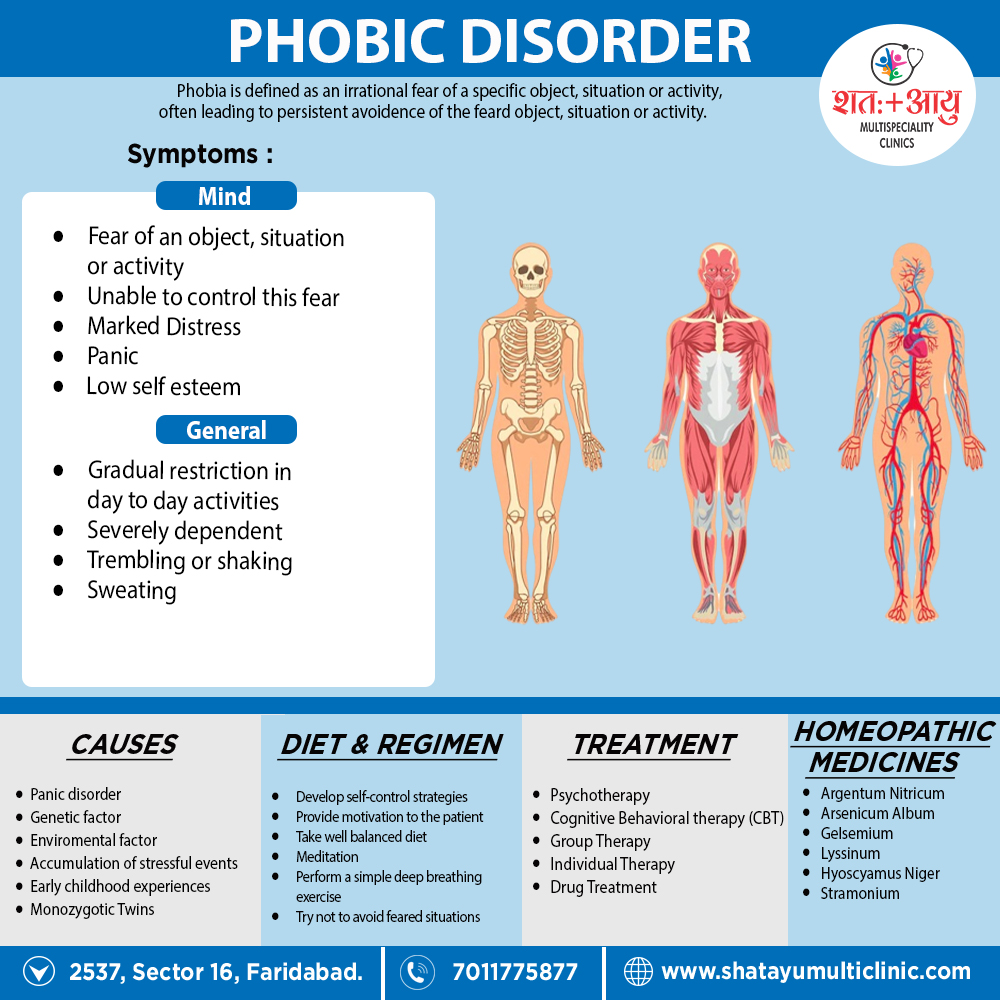Social Phobic Disorder:
Social phobia is incapacitating inappropriate anxiety in social situations which leads to the desire for escape or avoidance.
In the ICD-10 classification the term social phobia is preferred, whereas the DSM-IV uses the terms social phobia and social anxiety disorder interchangeably to describe the same condition. [1]
This is an example of irrational fear of activities or social interaction, characterised by an irrational fear of performing activities in the presence of other people or interacting with others.
The patient is afraid of his own actions being viewed by others critically, resulting in embarrassment or humiliation.
There is marked distress and disturbance in routine daily functioning.
Symptoms include:
- Fear of blushing (in other words, erythrophobia),
- Eating in company of others,
- Public speaking,
- Public performance (e.g. on stage),
- Participating in groups,
- Writing in public (e.g. signing a check),
- Speaking to strangers (e.g. for asking for directions),
- Dating,
- Speaking to authority,
- Urinating in a public lavatory (shy bladder). [2]
Avoidance: Sometimes the avoidance is partial; for example, entering a social group but failing to make conversation, or sitting in an inconspicuous place in the group.
Use of alcohol: Some people take alcohol to relieve anxiety, also alcohol abuse is more common among social phobics than among people with other phobias.
Low self-esteem: and perfectionism are common traits amongst those with social phobia.
Onset and Course:
The condition usually begins with an acute attack of anxiety in some public place.
Subsequently, anxiety occurs in similar places, with episodes that become gradually more severe also with increasing avoidance.
Co-morbidity:
About 80 percent of patients with social phobia will fit diagnostic criteria for another psychiatric disorder.
The most common are other anxiety disorders, depression, post-traumatic stress disorder (in other words, PTSD), and alcohol use disorders.
Etiology:
The cause of this Phobic Disorder is uncertain.
Symptoms usually start in late adolescence, a time when many young people are concerned about the impression they are making on other people.
It is possible that social phobias begin as exaggerated normal concerns, which are then increased and prolonged by thoughts that other people will be critical of any signs of anxiety.
It may be that styles of parenting and early childhood experiences influence the development of social anxiety.
Patients with social anxiety often remember their mother being fearful in social situations, and frequently describe their parents as overprotective.
Genetics certainly play a role in the aetiology of social anxiety disorder, but the extent of this is currently unknown.
Concordance rates for monozygotic twins (25 percent) are higher than for dizygotic twins (15 percent), and it known (but not quantified) that first-degree relatives of those with the disorder have a greater risk of developing it than the general population.
Differential diagnosis:
Generalized anxiety disorder:
Social phobia distinguish by the pattern of situations in which anxiety occurs.
Depressive disorder:
This Phobic Disorder distinguish by the pattern of situations and the absence of the core symptoms of low mood, anhedonia, and loss of energy.
Sometimes people who have previously coped with social phobia seek help when they become depressed.
Schizophrenia:
Occasionally, patients with schizophrenia are anxious in, and avoid, social situations because of overly suspicious delusions.
Anxious/avoidant personality disorder:
It is characterized by lifelong shyness and lack of self-confidence, may closely resemble social phobia.
However, personality disorder starts at a younger age and develops more gradually than social phobia.
Social inadequacy:
It is a primary lack of social skills with secondary anxiety. People with social phobia possess these social skills but cannot use them when they are anxious.
Treatment:
Antidepressant medication:
The best evidence is for the use of one of the SSRIs.
Paroxetine, fluvoxamine, escitalopram, and sertraline have reported to be effective in social phobia in the short term although the long-term benefits are less certain.
A second-line option is the SNRI venlafaxine, which is of similar efficacy to SSRIs but has a poorer side-effect profile.
Traditionally, the monoamine oxidase inhibitors (e.g. moclobemide) use for social anxiety, but the strict dietary restrictions needed to use them safely combined with adverse side effects mean their use is only justified when other medications prove ineffective.
While taking any antidepressant medication, patients should advise to practise exposure to situations that they have previously avoided.
Anxiolytic medication:
It provides immediate short-term relief, for example to help the patient deal with an important professional or social situation before more lasting treatment has taken effect.
However, anxiolytics should not use regularly because of the risk of dependence.
Beta-adrenergic antagonists (e.g. propranolol) are used occasionally to control tremor and palpitations unresponsive to anxiolytic treatment, but have not been shown to be better than placebo at controlling social anxiety when used on a regular basis.

